
Rattlesnakes in Colorado are most active during the spring months. During this time, you may come across a rattlesnake happily stretched out on the ground enjoying the sun. When the heat of summer hits, rattlesnakes tend to come out only in the mornings and evenings when it is not quite as hot. In the winter rattlesnakes go into brumation to escape the cold. Colorado is home to four different types of rattlesnakes and three unique species (as you will see, there are “subspecies” on this list, which means they are different but not quite different enough to be a separate species). Let’s take a closer look at the unique appearance and personality of each of Colorado’s four types of rattlesnakes.
1. Desert Massasauga
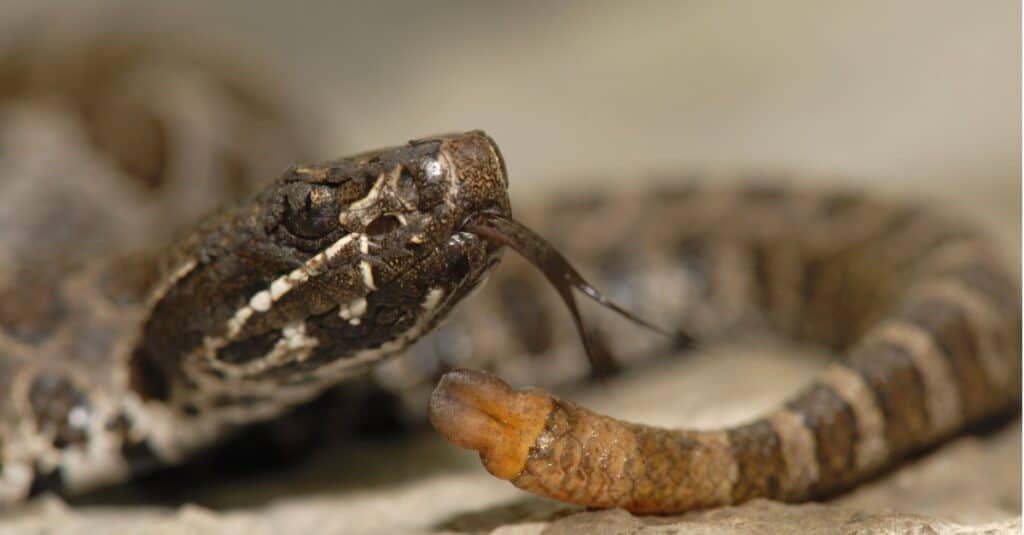
The desert massasauga rattlesnake is the smallest of the three subspecies of massasauga snakes.
©iStock.com/Shoemcfly
| Desert Massasauga | Stats |
|---|---|
| Range | Southeast Colorado |
| Length | 18 inches |
The desert massasauga lives in southeast Colorado. It can also be found in the Southwest United States and northern Mexico. These snakes are shy and not aggressive; they rarely attack when they feel threatened. Instead, they try to get away from the threat as quickly and quietly as possible. Sometimes desert massasaugas will rattle, but because they have such small rattles, the sound is softer than larger rattlesnakes. Some have described the desert massasauga’s rattle as sounding like crickets.
The desert massasauga is small and grows to only 18 inches long or less. This snake has a tan or gray colored body with brown spots or blotches along its back, helping it to blend into dry and sandy areas. Desert massasaugas also have dark cheek stripes on both sides of the face, with a thinner white line just beneath it. These snakes have long lives but low reproduction. In addition, urban development and farming have invaded much of their habitats. Desert massasauga rattlesnakes are a Species of Special Concern in Colorado.
2. Western Massasauga
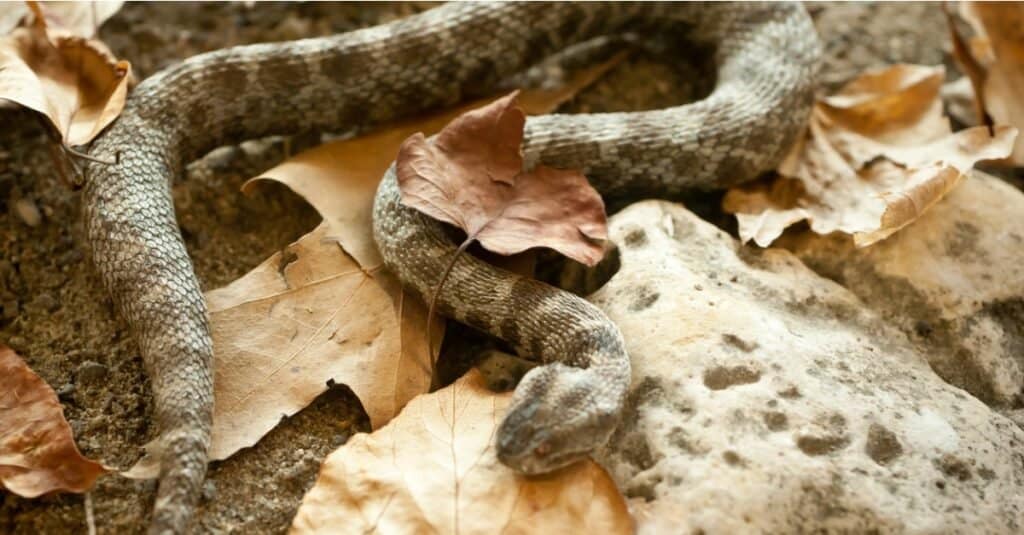
The western massasauga is paler and lighter than the desert massasauga, although the two look similar.
©iStock.com/Westhoff
| Western Massasauga | Stats |
|---|---|
| Range | Southeast Colorado |
| Length | 14-36 inches |
The western massasauga is a rattlesnake that lives only in Southeast Colorado, usually in sandy terrain. Western massasauga venom is cytotoxic. It destroys tissue and prevents blood from clotting. However, these snakes are calm and rarely bite humans. The western massasauga is a candidate for federal listing under the U.S. Endangered Species Act.
Western massasaugas grow to 14-36 inches in length, with light gray bodies and dark brown blotches along their backs. These rattlesnakes look similar to the desert massasauga. However, western massasaugas have lighter and paler base colors that make their dark blotches look much brighter. These snakes also have a distinctive dark stripe across each eye and down the side of their faces. Western massasauga rattlesnakes are sometimes called “Buzztails” because of the high-pitched sound of their rattles.
3. Prairie Rattlesnake

These rattlesnakes spend most of their time on the ground, but they can also climb trees.
©DMartin09/Shutterstock.com
| Prairie Rattlesnake | Stats |
|---|---|
| Range | All of Colorado |
| Length | 35-45 inches |
The prairie rattlesnake is the largest and most common rattlesnake in Colorado and can be found across the state in plains, grasslands, woodlands, and near rivers and lakes. At times these snakes may even wander into human communities like parks and homes as they seek out shady places to escape the heat of the sun. They are also common in populated areas because their primary source of food—rodents—also tend to congregate in urban environments. On occasion, however, prairie rattlesnakes will also eat birds, eggs, toads, frogs, lizards, and insects.
These snakes are 35-45 inches long and are mostly seen between April and September. When they feel threatened, prairie rattlesnakes will often remain motionless and blend into their surroundings with their camouflage coloring. Sometimes they will try to slither away quietly, and other times they will coil up and rattle, ready to strike if necessary.
Prairie rattlesnakes have camouflage coloring that helps them to blend into their environment. They are often brown, gray, or sage-green, with white-bordered brown blotches running along their bodies. There are dark ring markings at the end of the tail near the rattle. Their scales are keeled and rough, giving them a texture to blend into dry prairie regions. Another distinct feature are white stripes above and below the snake’s eyes. Colorado’s bull snakes are often mistaken for prairie rattlesnakes when seen from a distance. However, bull snakes are usually much bigger and are more aggressive.
4. Midget Faded Rattlesnake
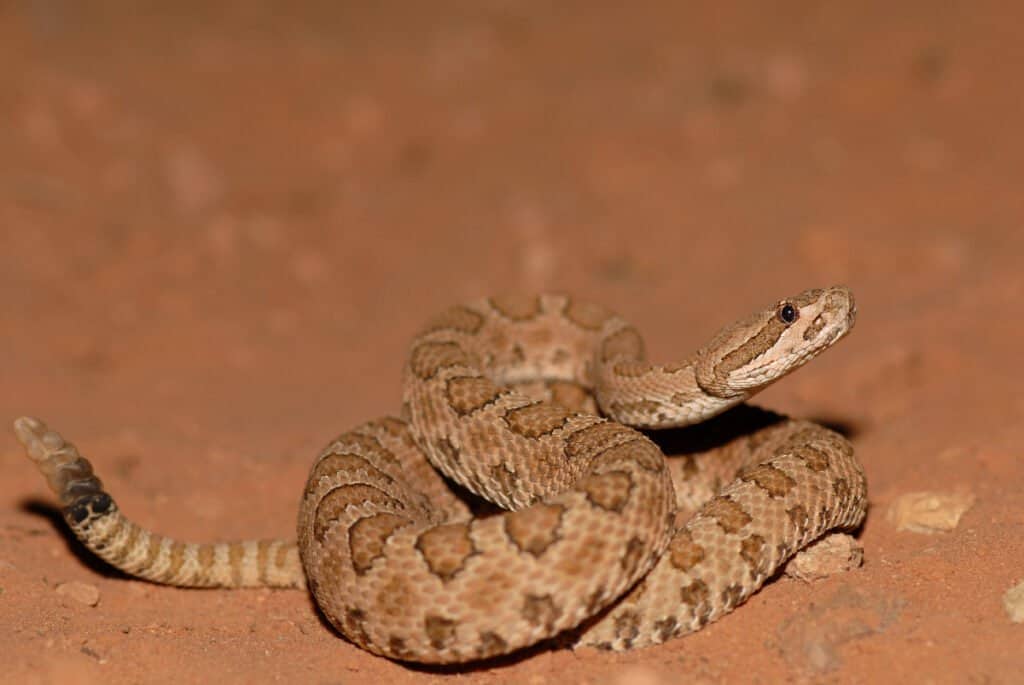
The midget faded rattlesnake’s venom is one of the most potent in North America.
©Rusty Dodson/Shutterstock.com
| Midget Faded Rattlesnake | Stats |
|---|---|
| Range | Green River Basin & Colorado River Basin |
| Length | 25 inches or less |
The midget faded rattlesnake lives in limited areas of the Green River Basin and the Colorado River Basin. This snake can also be found in Wyoming and the eastern part of Utah. It is a smaller rattlesnake, only 25 inches long at the most. Midget faded rattlesnakes have colors that blend into the Colorado landscape, like cream, tan, yellow-brown, pink, or red. There are darkly outlined rectangular blotches running along their bodies that fade as they age. These light colors combined with faded markings help them to blend into the environment.
Midget faded rattlesnakes primarily hunt cold-blooded animals like lizards. Even though these snakes are smaller, they have potent neurotoxic-myotoxic venom that is as powerful as any other viper in North America. In fact, the venom of a prairie rattlesnake can be even more toxic than some cobras. Midget faded rattlesnakes are a subspecies of the western rattlesnake and are sometimes called yellow rattlesnakes in Colorado. These snakes rely on dens and shelters more than many other rattlesnakes do. Midget faded rattlesnakes use their dens when they are young, for gestation, and when they shed, as well as for their winter brumation.
Rattlesnake Danger in Colorado
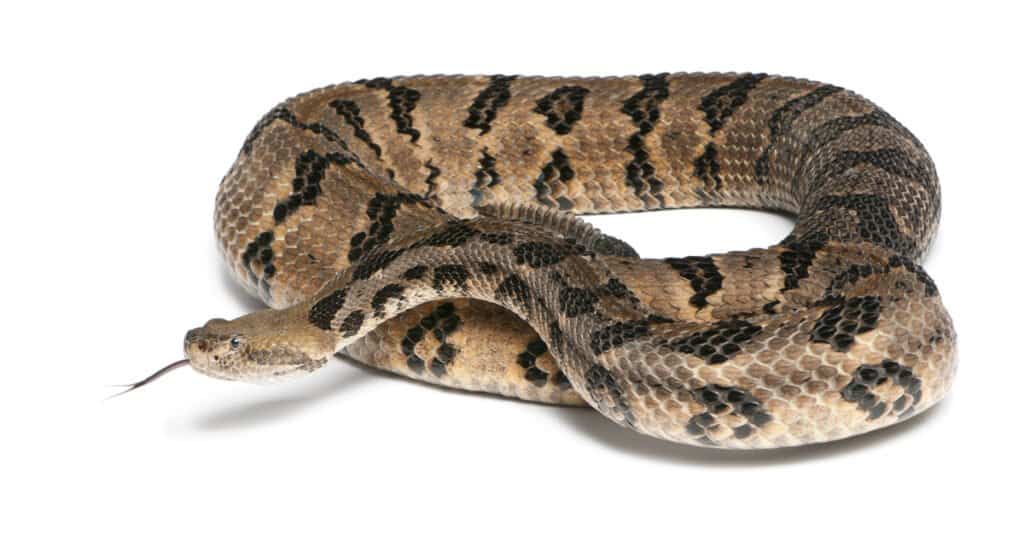
Most hospitals can provide antivenom to counteract the venom from a wide variety of rattlesnake species.
©fivespots/Shutterstock.com
The four species of rattlesnake living in Colorado are all relatively nonaggressive. However, they will still defend and can strike when they feel it is necessary. If you see a rattlesnake, be sure to give it a wide berth, keeping several feet away from the snake. When hiking, be sure to look before stepping near cracks or crevices of rocks.
If you do get bit by a rattlesnake, it is important to stay calm. Do not attempt to kill the rattlesnake or bring it with you for treatment. Hospitals have anti-venom that is effective across multiple species of rattlesnakes, so they do not need you to identify the snake. Additionally, trying to kill or capture a rattlesnake will likely result in getting bit again. If you are worried, take a picture of the snake on your phone. Do not use a tourniquet to treat your wound (it will make your injury worse), and do not try to suck the venom out. Get medical attention as soon as possible.
Other Venomous Animals Which Live in Colorado

The brown recluse spider produces venom that will destroy blood vessels, nerves, and tissue.
©Nick626/Shutterstock.com
- The Brown Recluse: One of North America’s most dangerous arachnids, this arthropod is also referred to as the fiddleback spider. When it strikes, its bite is not felt immediately. However, its venom is more potent than a rattlesnake’s and is not only fast acting, but capable of destroying blood vessels, nerves, and tissue. Treatment should be sought instantly in the event of your noticing two puncture holes and a burning sensation.
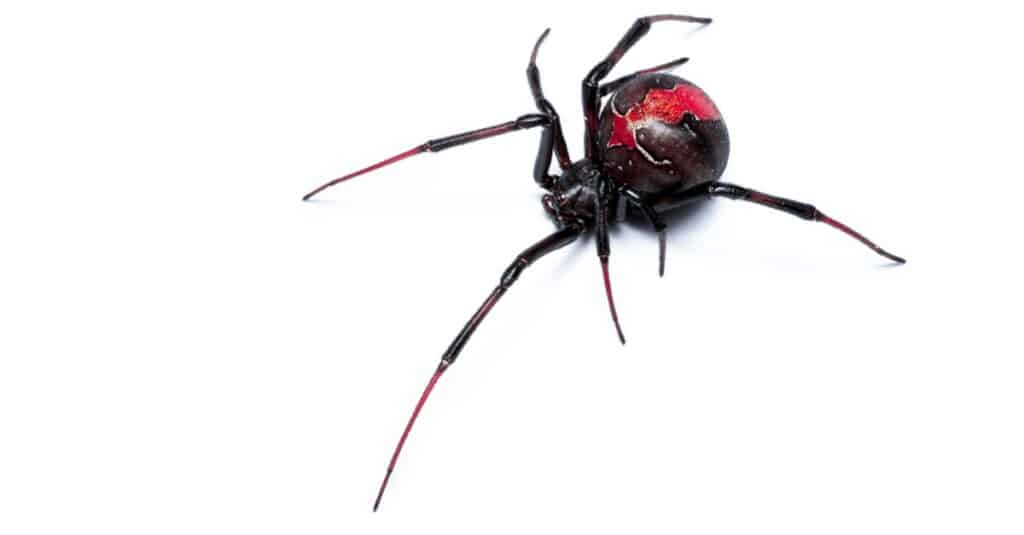
Black widow venom is especially dangerous since it is capable of affecting the nervous system.
©Steven Giles/Shutterstock.com
- The Black Widow: The status of the most dangerous spider, and arachnid, however, goes to the black widow. This spider which often has a single reddish marking (or more) on the underside of its black abdomen, is capable of producing latrotoxin a venom which is specific to members of the Latrodectus genus. Symptoms include acute pain, nausea, excessive perspiration, tachycardia, and may last for 72 or up to a week – or even longer.
Summary of the 4 Types of Rattlesnakes in Colorado
| Index | Species | Location |
|---|---|---|
| 1 | Desert Massasauga | Southwest United States and Northern Mexico |
| 2 | Western Massasauga | Southeast Colorado |
| 3 | Prairie Rattlesnake | Throughout Colorado |
| 4 | Midget Faded Rattlesnake | The Green River Basin, the Colorado River Basin. It is also found in Wyoming and the eastern part of Utah. |
The photo featured at the top of this post is © Nina B/Shutterstock.com
Discover the "Monster" Snake 5X Bigger than an Anaconda
Every day A-Z Animals sends out some of the most incredible facts in the world from our free newsletter. Want to discover the 10 most beautiful snakes in the world, a "snake island" where you're never more than 3 feet from danger, or a "monster" snake 5X larger than an anaconda? Then sign up right now and you'll start receiving our daily newsletter absolutely free.
Thank you for reading! Have some feedback for us? Contact the AZ Animals editorial team.






